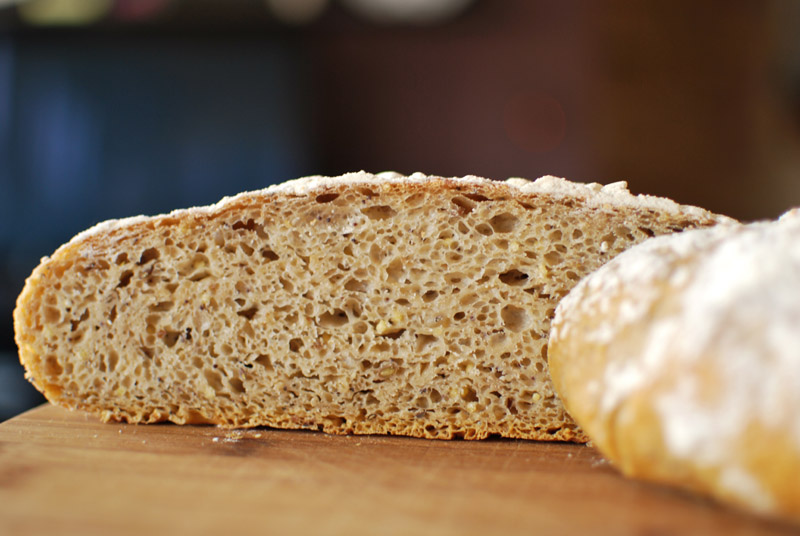Week Thirty-Nine: No-Knead Bread Week
The next logical variation on this week’s theme is to see how this bread reacts to some additions. I fully understand I’m not blazing any new territory here; but it’s something I’ve never tried for myself before. Exciting!
The simplest addition you can make to any bread is to add different grains and seeds to the dough, so that’s the route I’m taking today. This version remains a fairly light multigrain bread, mostly composed of white bread flour, but there’s a decent amount of whole wheat flour, with a handful of rye thrown in for complexity. For me, though, the interesting part comes from the other additions, which can be whatever combination of grains or seeds you like best, or happen to have lying around. Here, I’ve used a mixture of yellow millet, to pop between your teeth, hearty steel-cut oats (old-fashioned rolled oats would do just as well, but I prefer the more rustic texture of steel-cut), ground flaxseed for a nutty flavor throughout, and poppy seeds, with their sultry, dusky purple flavor.
To add some tang, there’s a touch of plain yogurt in the dough, which, like the use of white vinegar, helps replicate the acidic notes of a real wild-yeast sourdough. Yogurt, being a dairy product, does help soften the crumb a little, though the effect here is slight. More noticeable is the quite welcome sour flavor it lends, which is lovely in conjunction with the hint of rye flour.
The overall taste is nicely balanced between the pleasant coarseness of whole grains and the softness of a typical white bread, punctuated with the complementing flavors of poppy, flax, and oat. The crust is perhaps thinner than the original no-knead bread, but not greatly. A bite lands on your tongue with none of the dryness that plagues so many multigrain breads, leaving an almost creamy sweetness instead. Though it wasn’t the tallest riser, that’s to be expected from such heavy additions as grains and seeds; it absolutely had a more open crumb than many other multigrain breads I’ve made.
Yes, this is one of the more successful no-knead variations I’ve yet seen, one that was well thought out in inception and actually follows through in execution. Here, the no-knead method really shines, not interfering with the potential success of well-proportioned ingredients (and vice-versa), doing just what the method is intended to do: create a great loaf of bread with the minimum possible effort. Thanks much to Breadtopia for the original recipe!

yes, these pictures are all starting to look the same; I decided it'd be easiest to compare the different loaves this way
Multigrain No-Knead Bread
Adapted from Breadtopia
Makes 1 round loaf
12 ounces (2½ cups) unbleached bread flour, plus extra for dusting
3 ounces (2/3 cup) whole wheat flour
1 ounce (1/4 cup) rye flour
2 tablespoons ground flaxseed
2 tablespoons millet
1 tablespoon steel-cut oats
2 teaspoons poppy seeds
1½ teaspoons salt
1/4 teaspoon instant yeast
1½ cups water
2 tablespoons plain yogurt
1. In a large bowl, whisk together the flours, flaxseed, millet, oats, poppy seeds, salt, and yeast. Add the water and yogurt, and stir until blended; the dough will be shaggy and sticky. Cover tightly with plastic wrap, and let dough sit at room temperature for at least 12 and up to 24 hours (but preferably about 18).
2. The dough is ready when its surface is dotted with bubbles. Line a 10 inch skillet or any wide, shallow bowl with a large square of parchment paper. Turn the dough out onto a well-floured work surface; sprinkle it with a little more flour and fold it over on itself a few times, until it forms a roughly round shape. A bench scraper helps greatly with this step.
3. Transfer the dough to the parchment-lined skillet, and dust heavily with additional flour (or wheat bran, if you like). Cover loosely with plastic wrap and let rise until doubled in size, about 2 hours. When it is ready, the dough will not readily spring back when poked gently with a fingertip.
4. At least 30 minutes before baking, preheat the oven to 500º F. Put a 6- to 8-quart heavy covered pot (see note 1 below) in oven as it heats, on a rack set to the lowest position. When the dough is ready, carefully remove the pot from the oven. Transfer the dough to the pot by lifting the parchment by the edges, and carefully and quickly lowering the dough into the pot. Shake the pan once or twice if dough is unevenly distributed, but don’t worry about it too much; it will straighten out as it bakes.
5. Cover the pot with the lid, and bake at 500º F for 30 minutes. Reduce the temperature to 425º F, remove the lid, and bake uncovered for an additional 15 to 30 minutes, or until the loaf is well-browned. An instant-read thermometer should register around 205º to 210º F when fully baked. Transfer to a wire rack to cool thoroughly, discarding the parchment.
Notes:
1. Any heavy covered pot will do, be it cast iron, enamel, Pyrex, stainless steel, or ceramic. As long as it’s oven-safe, it seems anything will do the trick. If your chosen vessel has no lid, or if you’re concerned about the oven-safety of it, simply use aluminum foil instead, pressing it tightly (and carefully) around the preheated pot.

